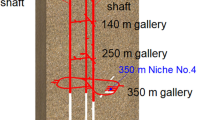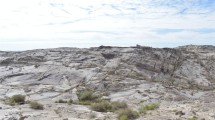Abstract
Safety assessments related to the long-term migration of radionuclides in high-level radioactive waste disposal repositories need to consider the evolution of permeability associated with excavation-damaged-zone (EDZ) fractures. We observed EDZ fractures preserved by resin injection around a gallery in the Horonobe Underground Research Laboratory in Japan with the aim of assessing the sensitivity of aperture to shear displacement (i.e., dilation angle) in EDZ fractures. To date, shear displacement along EDZ fractures has not been quantified despite its importance for estimating the evolution of fracture aperture around excavations after the repository is backfilled. Enlarged photographs of EDZ fractures fixed by resin were examined to obtain reliable and accurate measurements of the shear displacement and aperture of EDZ fractures without additional disturbance. Measured shear displacement and fracture aperture are poorly correlated, meaning that fracture aperture is insensitive to shear displacement after fracture formation. This insensitivity is closely reproduced by a previously reported empirical relationship and is attributed to the relatively high levels of normal stress acting on fracture surfaces at 350 m depth, which suppress shear-induced dilatation. Considering this insensitivity between fracture aperture and shear displacement, shear-induced dilation of EDZ fractures is estimated to be negligible even if the fractures are shear-displaced after the repository is backfilled, so long as the normal stress acting on fracture surfaces does not reduce substantially. The applied resin injection and fracture observations constitute a useful tool for helping to assess the likelihood of shear-induced dilation after the repository is backfilled.
Highlights
-
We injected low-viscosity resin with low injection pressure around a gallery to observe the shear displacement and aper-ture of EDZ fractures.
-
The observed shear displacement and fracture aperture are poorly correlated, implying that aperture is insensitive to shear displacement.
-
Relatively high levels of normal stress acting on the fracture surface at 350 m depth suppress shear-induced dilation.
-
Applied methods are useful for assessing the likelihood of shear-induced dilation of EDZ fractures after the repository is backfilled.

















Similar content being viewed by others
References
ANDRA (2005) Dossier 2005 Argile Tome Safety evaluation of a geological repository, France
Aoyagi K, Ishii E (2019) A Method for estimating the highest potential hydraulic conductivity in the excavation damaged zone in mudstone. Rock Mech Rock Eng 52:385–401
Aoyagi K, Tsusaka K, Tokiwa T, Kondo K, Inagaki D, Kato H (2013) A Study of the regional stress and the stress state in the galleries of the Horonobe Underground Research Laboratory. In: Proc 6th International Symposium on In-situ Rock Stress (RS 2013), pp 331–336
Aoyagi K, Ishii E, Ishida T (2017a) Field observations and failure analysis of an excavation damaged zone in the Horonobe Underground Research Laboratory. J MMIJ 133:25–33
Aoyagi K, Chen Y, Sakurai A, Ishii E, Ishida T (2017b) Visualization of fractures in an excavation damaged zone in the Horonobe Underground Research Laboratory (Joint Research). Technical Report. Japan Atomic Energy Agency, JAEA-Research 2017-014
Aoyagi K, Chen Y, Ishii E, Sakurai A, Ishida T (2019) Visualization of fractures induced around the gallery wall in Horonobe Underground Research Laboratory. In: Proceedings of the 5th ISRM Young Scholar’s Symposium on rock mechanics and the International Symposium on rock engineering for innovative future
Aoyagi K, Chen Y, Sakurai A, Ishii E, Ishida T (2020) Visualization of fractures in an excavation damaged zone in the Horonobe Underground Research Laboratory: part 2 (Joint Research). Technical Report. Japan Atomic Energy Agency, JAEA-Research 2019-014
Armand G, Wileveau Y, Morel J, Cruchaudet M, Rebours H (2007) Excavation damaged zone in the meuse haute marne underground research laboratory. In: Proc. 11th Congress of the International Society for Rock Mechanics, pp 33–36
Armand G, Leveau F, Nussbaum C, Vaissiere RL, Noiret A, Jaeggi D, Landrein P, Righini C (2014) Geometry and properties of the excavation-induced fractures at the Meuse/Haute-Marne URL drifts. Rock Mech Rock Eng 47:21–41
Asadollahi P, Tonon F (2010) Constitutive model for rock fractures: revisiting Barton’s empirical model. Eng Geol 113:11–32
Bandis S, Lumsden AC, Barton NR (1981) Experimental studies of scale effects on the shear behavior of rock joints. Int J Rock Mech Min Sci Geomech Abstr 18:1–21
Bandis SC, Lumsden AC, Barton NR (1983) Fundamentals of rock joint deformation. Int J Rock Mech Min Sci Geomech Abstr 20:249–268
Barton N, Bandis S, Bakhtar K (1985) Strength, deformation and conductivity coupling of rock joints. Int J Rock Mech Min Sci Geomech Abstr 22:121–140
Blumling P, Bernier F, Lebon P, Martin CD (2007) The excavation damaged zone in clay formations time-dependent behavior and influence on performance assessment. Phys Chem Earth 32:588–599
Bock H, Dehandschutter B, Martin CD, Mazurek M, Haller A, Skoczylas F, Davy C (2010) Self-sealing of Fractures in Argillaceous Formations in the Context of Geological Disposal of Radioactive Waste. OECD PUBLICATIONS, NEA No. 6184
Bossart P, Meier PM, Moeri A, Trick T, Mayor JC (2002) Geological and hydraulic characterization of the excavation disturbed zone in the Opalinus Clay of the Mont Terri Rock Laboratory. Eng Geol 66:19–38
Bossart P, Trick T, Meier PM, Mayor JC (2004) Structural and hydrogeological characterization of the excavation-disturbed zone in the Opalinus Clay (Mont Terri Project, Switzerland). Appl Clay Sci 26:429–448
Gudmundsson A (2010) Rock fractures in geological processes. Cambridge University Press
Hsiung SM, Chowdhury AH, Nataraja MS (2005) Numerical simulation of thermal-mechanical process observed at the Drift-Scale Heater Test at Yucca Mountain, Nevada, USA. Int J Rock Mech Min Sci 42:652–666
International Society for Rock Mechanics (1978a) Suggested methods for determining tensile strength of rock materials. Int J Rock Mech Min Sci Geomech Abstr 15:99–103
International Society for Rock Mechanics (1978b) Suggested methods for determining sound velocity. Int J Rock Mech Min Sci Geomech Abstr 15:53–58
International Society for Rock Mechanics (1978c) Suggested Methods for the quantitative description of discontinuities in rock masses. Int J Rock Mech Min Sci Geomech Abstr 15:319–368
International Society for Rock Mechanics (1979a) Suggested methods for determining the uniaxial compressive strength and deformability of rock materials. Int J Rock Mech Min Sci Geomech Abstr 16:135–140
International Society for Rock Mechanics (1979b) Suggested methods for determining water content, porosity, density, absorption and related properties and swelling and slake-durability index properties. Int J Rock Mech Min Sci Geomech Abstr 16:143–151
Ishii E (2016) Far-field stress dependency of the failure mode of damage-zone fractures in fault zones: Results from laboratory tests and field observations of siliceous mudstone. J Geophys Res 121:70–91
Ishii E (2020) A conventional straddle-sliding-packer system as a borehole extensometer: monitoring shear displacement of a fault during an injection test. Eng Geol 275:105748
Ishii E (2021) The highest potential transmissivities of fractures in fault zones: Reference values based on laboratory and in situ hydro-mechanical experimental data. Eng Geol 294:106369
Japan Nuclear Cycle Development Institute (2000) H12: project to establish the scientific and technical basis for HLW disposal in Japan—report 3 safety assessment of the geological disposal system. Technical report. JNC TN1410 2000-004, Tokai-mura, Japan
Kupferschmied N, Wild KM, Amann F, Nussbaum C, Jaeggi D, Badertscher N (2015) Time-dependent fracture formation around a borehole in a clay shale. Int J Rock Mech Min Sci 77:105–114
Li Y, Zhang Y (2015) Quantitative estimation of joint roughness coefficient using statistical parameters. Int J Rock Mech Min Sci 77:27–35
Marschall P, Giger S, De La Vassière R, Shao H, Leung H, Nussbaum C, Trick T, Lanyon B, Senger R, Lisjak A, Alcolea A (2017) Hydro-mechanical evolution of the EDZ as transport path for radionuclides and gas: insights from the Mont Terri rock laboratory (Switzerland). Swiss J Geosci 110:173–194
Mezawa T, Mochizuki A, Miyakawa K, Sasamoto H (2017) Groundwater pressure records by geochemical monitoring system in the Horonobe Underground Research Laboratory. Technical Report. JAEA-Data/Code 2017-010
Muraoka H, Kamata H (1983) Displacement distribution along minor fault traces. J Struct Geol 5:483–495
Nuclear Waste Management Organization of Japan (2013) Safety of the Geological Disposal Project 2010—Safe Geological Disposal Based on Reliable Technologies. Tech Rep NUMO-TR-13-05
Nuclear Waste Management Organization of Japan (2021) Realization of safe geological disposal of high-level radioactive waste and TRU waste in Japan - development of a safety case for the selection of an appropriate site. Tech Rep NUMO-TR-20-03 (in Japanese)
Olsson R, Barton N (2001) An improved model for hydromechanical coupling during shearing of rock joints. Int J Rock Mech Min Sci 38:317–329
Peacock DCP (1991) Displacements and segment linkage in strike-slip fault zones. J Struct Geol 14:1025–1035
Rutqvist J, Noorishad J, Tsang CF, Stephansson O (1998) Determination of fracture storativity in hard rocks using high-pressure injection testing. Water Resour Res 34:2551–2560
Schultz RA, Soliva R, Fossen H, Okubo CH, Reeves DM (2008) Dependence of displacement-length scaling relations for fractures and deformation bands on the volumetric changes across them. J Struct Geol 30:1405–1411
Tsang CF, Bernier F, Davies C (2005) Geohydromechanical processes in the excavation damage zone in crystalline rock, rock salt, and indurated and plastic clays in the context of radioactive waste disposal. Int J Rock Mech Min Sci 42:109–125
Vermilye JM, Sholtz CH (1995) Relation between vein length and aperture. J Struct Geol 17:423–434
Yoshino H, Kishi A, Yokota H (2015) Long-term Pore-pressure-monitoring Using Deep Boreholes in the Horonobe Underground Research Project. Technical Report. JAEA-Data/Code 2015–014
Acknowledgements
We thank Toagosei Co., Ltd. for developing the resin used in the experiment. Mr. Hirokazu Fujii of Lazoc Inc. kindly assisted with resin injection. We also thank two anonymous reviewers for their helpful comments and the Editor-in-Chief, Jean Sulem, for editorial handling of the manuscript.
Author information
Authors and Affiliations
Corresponding author
Additional information
Publisher's Note
Springer Nature remains neutral with regard to jurisdictional claims in published maps and institutional affiliations.
Rights and permissions
About this article
Cite this article
Aoyagi, K., Ishii, E., Chen, Y. et al. Resin-Injection Testing and Measurement of the Shear Displacement and Aperture of Excavation-Damaged-Zone Fractures: A Case Study of Mudstone at the Horonobe Underground Research Laboratory, Japan. Rock Mech Rock Eng 55, 1855–1869 (2022). https://doi.org/10.1007/s00603-022-02777-z
Received:
Accepted:
Published:
Issue Date:
DOI: https://doi.org/10.1007/s00603-022-02777-z




